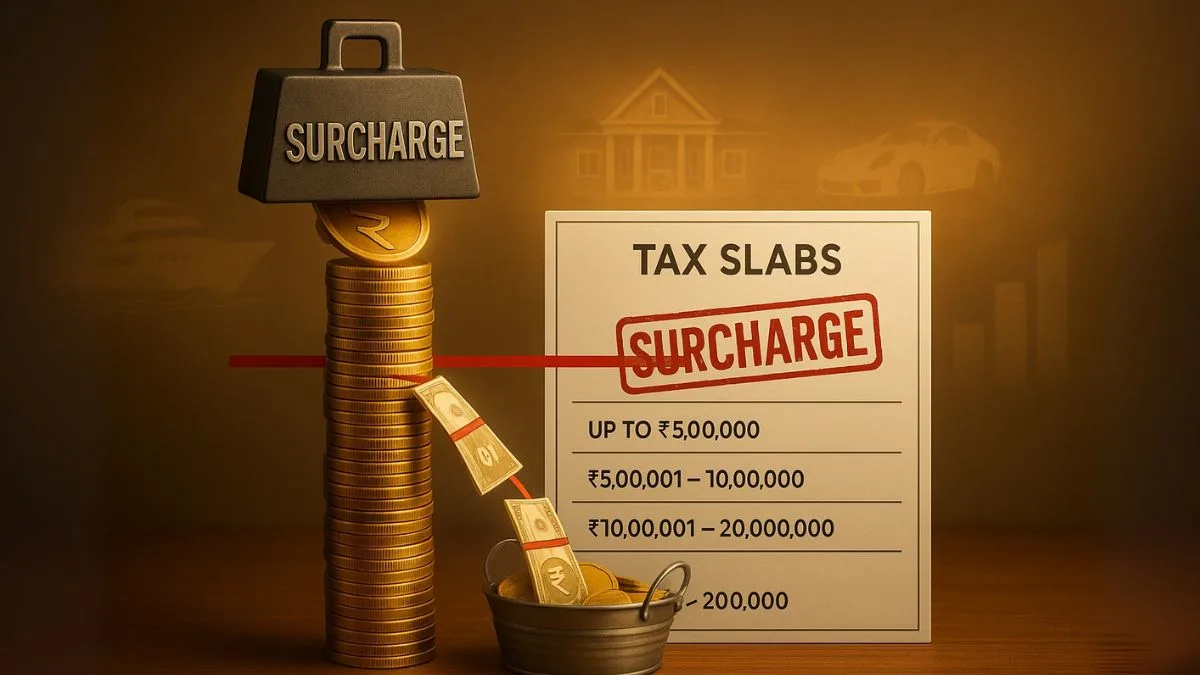
A surcharge is an additional charge on the income tax payable. It is not a separate tax but an extra amount levied on the basic income tax when a taxpayer’s income crosses specific thresholds. In simple words, it acts like a premium that high-income taxpayers pay over and above their normal income tax.
For example, if your basic tax liability is ₹10 lakh, and a surcharge of 15% applies, then an additional ₹1.5 lakh must be paid as surcharge. Thus, the surcharge directly increases the tax burden for high-income earners.
Why Does Surcharge Exist?
The main purpose of a surcharge is progressive taxation—ensuring that individuals & entities earning higher incomes contribute more to government revenues. Unlike flat-rate taxes, a surcharge targets wealthy taxpayers without impacting lower-income groups.
By linking surcharge with income tax slabs, the government ensures fairness: the more you earn, the higher your effective tax liability."
Applicability of Surcharge Under Income Tax Act
The surcharge section in Income Tax clearly specifies when it becomes applicable. It applies to:
- Individuals / HUFs whose income exceeds prescribed limits.
- Firms, LLPs, and companies with higher taxable income.
- Specific cases under special provisions, such as sections 115BBE (unexplained income) and 115BAA (domestic companies opting for concessional tax rates).
Current Surcharge Rates (FY 2025–26, AY 2026–27)
The surcharge rates vary based on the Income Tax Slab and type of taxpayer.
- Individuals / HUFs / AOPs / BOIs
- 10% surcharge: Income between ₹50 lakh & ₹1 crore
- 15% surcharge: Income between ₹1 crore and ₹2 crore
- 25% surcharge: Income between ₹2 crore & ₹5 crore (except dividend and capital gains income)
- 37% surcharge: Income above ₹5 crore (except dividend and capital gains income, where it is capped at 15%)
- Firms and LLPs
- Flat 12% surcharge when income exceeds ₹1 crore.
- Companies
- Domestic companies: 7% or 12% surcharge depending on income levels.
- Foreign companies: 2% or 5% surcharge based on income thresholds.
Also Read: New Manufacturing Companies Tax Rate at 15%
Illustration of Surcharge Calculation
Let’s say an individual has a taxable income of ₹1.5 crore. The basic tax payable as per the income tax slab is ₹45 lakh. Now, since income exceeds ₹1 crore but is below ₹2 crore, a surcharge of 15% will be levied on the income tax payable.
- Basic tax: ₹45,00,000
- Surcharge @15%: ₹6,75,000
- Total tax before cess: ₹51,75,000
This shows how surcharge significantly increases the overall liability.
Sections Governing Surcharge
The surcharge section under the Income Tax Act is not one single section, but spread across multiple provisions. Important references include:
- Section 2 & Section 4: Define chargeability.
- Section 115BBE: Higher surcharge on unexplained income.
- Section 115BAA / 115BAB: Concessional company tax regimes that specify surcharge caps."
- Finance Acts: Each year’s Finance Act prescribes surcharge rates.
Thus, surcharge is a dynamic levy that can change with budget announcements.
Relationship Between Income Tax Slab, Income Tax Rate, and Surcharge
To compute surcharge correctly, three elements must align:
- Income Tax Slab – determines the basic tax.
- Income Tax Rate – applied on income as per slab.
- Surcharge – applied on the final tax liability if income crosses thresholds.
This layering makes tax calculations more complex, but ensures fairness.
Also Read: The Tax Sword on Unexplained Income
Marginal Relief in Case of Surcharge
A unique concept associated with surcharge is marginal relief. Sometimes, due to a small increase in income, a taxpayer may face a disproportionately high surcharge. To prevent this unfairness, marginal relief ensures that the additional tax (including surcharge) is not more than the income exceeding the threshold.
Example: If your income is ₹1,00,01,000 (just ₹1,000 above ₹1 crore), the extra tax due to surcharge cannot exceed ₹1,000.
Impact of Surcharge on High Net-Worth Individuals (HNIs)
For HNIs, surcharge can drastically raise effective tax rates. For instance, an income above ₹5 crore may face an effective tax rate of nearly 42.7% (including surcharge & cess). To manage this, careful tax planning, investments, and the use of exemptions are necessary.
Surcharge on Special Incomes
Certain types of income like dividends and capital gains are treated differently. The surcharge on these is capped at 15% to prevent excessively high taxation.
Similarly, under Section 115BBE, surcharge is higher to discourage holding of unaccounted or unexplained income.
Surcharge for Companies and Firms
- Domestic companies opting under section 115BAA (22% tax rate) or 115BAB (15% tax rate) are subject to a capped surcharge of 10%."
- Firms and LLPs uniformly face a surcharge of 12% once income crosses ₹1 crore.
Criticism and Debates Around Surcharge
While surcharge strengthens revenue collection, critics argue that it complicates the tax system. Having multiple surcharge rates creates uncertainty & discourages global investors who prefer simple, predictable taxation.
Also Read: Alternate Minimum Tax for Non-Corporates Explained
Conclusion
The surcharge section in Income Tax is one of the most crucial tools for progressive taxation in India. By levying additional charges on the income tax payable of high-income earners, it ensures fairness in the system. However, taxpayers must carefully calculate surcharge along with Income Tax Slabs and Rates to avoid surprises during filing.
👉 Want to know how surcharge will affect your tax liability for FY 2025–26? Get expert guidance and seamless filing support at Callmyca.com—your trusted tax partner.











